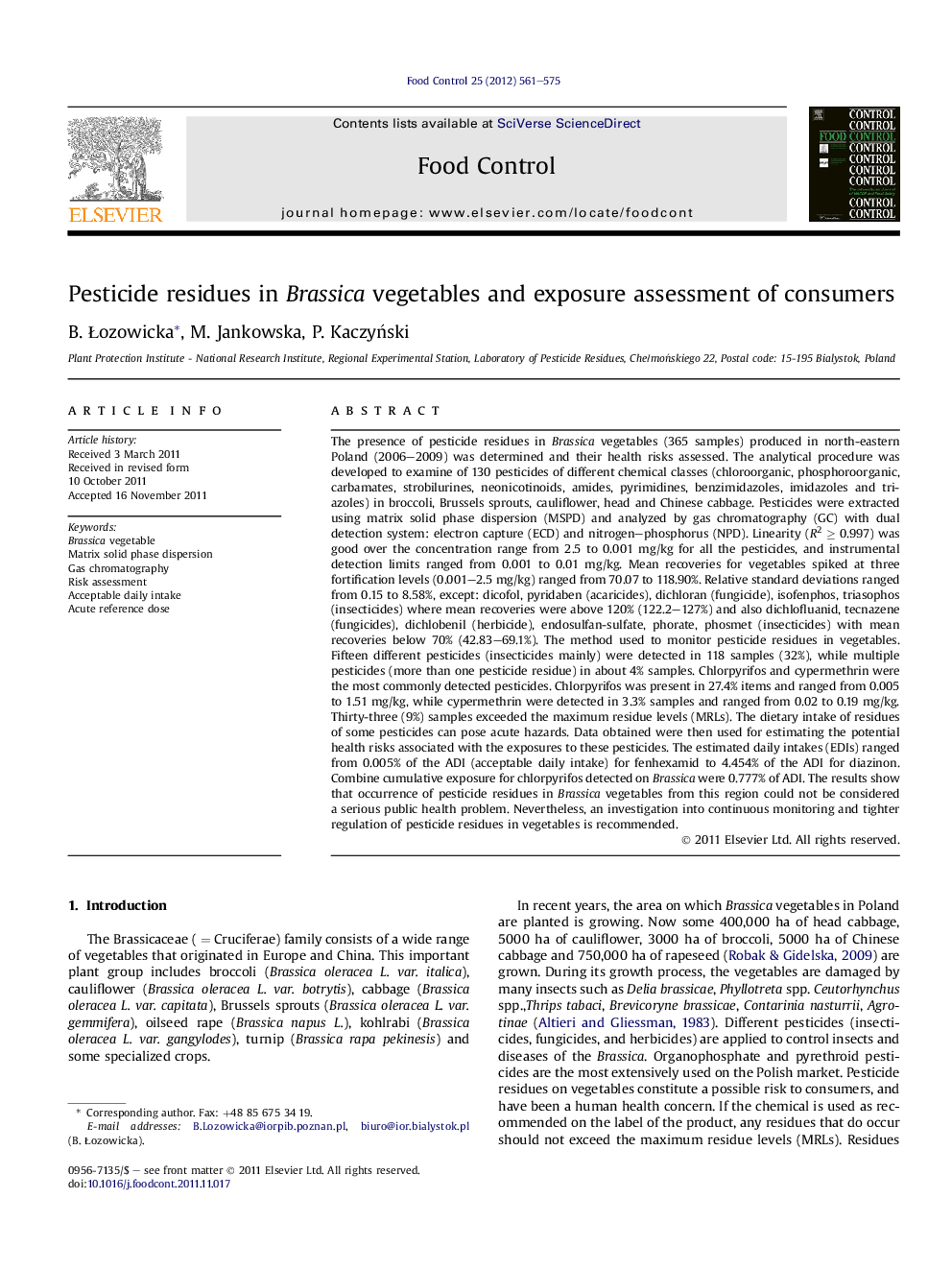| کد مقاله | کد نشریه | سال انتشار | مقاله انگلیسی | نسخه تمام متن |
|---|---|---|---|---|
| 6393594 | 1330454 | 2012 | 15 صفحه PDF | دانلود رایگان |

The presence of pesticide residues in Brassica vegetables (365 samples) produced in north-eastern Poland (2006-2009) was determined and their health risks assessed. The analytical procedure was developed to examine of 130 pesticides of different chemical classes (chloroorganic, phosphoroorganic, carbamates, strobilurines, neonicotinoids, amides, pyrimidines, benzimidazoles, imidazoles and triazoles) in broccoli, Brussels sprouts, cauliflower, head and Chinese cabbage. Pesticides were extracted using matrix solid phase dispersion (MSPD) and analyzed by gas chromatography (GC) with dual detection system: electron capture (ECD) and nitrogen-phosphorus (NPD). Linearity (R2 â¥Â 0.997) was good over the concentration range from 2.5 to 0.001 mg/kg for all the pesticides, and instrumental detection limits ranged from 0.001 to 0.01 mg/kg. Mean recoveries for vegetables spiked at three fortification levels (0.001-2.5 mg/kg) ranged from 70.07 to 118.90%. Relative standard deviations ranged from 0.15 to 8.58%, except: dicofol, pyridaben (acaricides), dichloran (fungicide), isofenphos, triasophos (insecticides) where mean recoveries were above 120% (122.2-127%) and also dichlofluanid, tecnazene (fungicides), dichlobenil (herbicide), endosulfan-sulfate, phorate, phosmet (insecticides) with mean recoveries below 70% (42.83-69.1%). The method used to monitor pesticide residues in vegetables. Fifteen different pesticides (insecticides mainly) were detected in 118 samples (32%), while multiple pesticides (more than one pesticide residue) in about 4% samples. Chlorpyrifos and cypermethrin were the most commonly detected pesticides. Chlorpyrifos was present in 27.4% items and ranged from 0.005 to 1.51 mg/kg, while cypermethrin were detected in 3.3% samples and ranged from 0.02 to 0.19 mg/kg. Thirty-three (9%) samples exceeded the maximum residue levels (MRLs). The dietary intake of residues of some pesticides can pose acute hazards. Data obtained were then used for estimating the potential health risks associated with the exposures to these pesticides. The estimated daily intakes (EDIs) ranged from 0.005% of the ADI (acceptable daily intake) for fenhexamid to 4.454% of the ADI for diazinon. Combine cumulative exposure for chlorpyrifos detected on Brassica were 0.777% of ADI. The results show that occurrence of pesticide residues in Brassica vegetables from this region could not be considered a serious public health problem. Nevertheless, an investigation into continuous monitoring and tighter regulation of pesticide residues in vegetables is recommended.
⺠We determined pesticide residues in Brassica vegetables and assessed health risks. ⺠We developed analytical method to examine of 130 pesticides. ⺠Matrix solid phase dispersion followed by gas chromatography was used. ⺠Chlorpyrifos and cypermethrin were the most commonly detected pesticides. ⺠An exposure assessment confirms that they are safe for consumers.
Journal: Food Control - Volume 25, Issue 2, June 2012, Pages 561-575